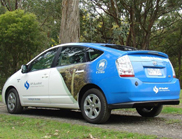Oct 27 2009
A road trial of plug-in hybrid electric vehicles (PHEVs), which could one day end up in every Australian driveway, is underway.
 The road trial will monitor the travel patterns, battery capacity and performance of the plug-in hybrid electric vehicles
The road trial will monitor the travel patterns, battery capacity and performance of the plug-in hybrid electric vehicles
Over the next three months, staff from Victorian energy distributor SP AusNet will use the PHEVs for their daily drive to work and for leisure as part of CSIRO and SP AusNet trial.
CSIRO engineers have modified the PHEVs to carry a 30Ah NiMH battery which is capable of holding a 6kw charge, and a battery charger, to allow the cars to plug into and charge with electricity from the grid or from on-site renewable energy sources.
CSIRO Energy Transformed Flagship scientist Dr Phillip Paevere said the road trial is collecting extensive information on how the existing PHEV technology could be used for a new application: using the car as a large mobile battery which can be integrated and used in the home.
“The PHEVs have been fitted with instruments which will monitor the travel patterns of different users, and the residual battery power left in the car at the end of the day, which could be available for other uses,” Dr Paevere said.
“When not needed, the parked car in the driveway could potentially become a large battery store and energy source for the house, running appliances or storing off-peak or surplus electricity generated from on-site renewable generators, such as solar panels.”
SP AusNet spokesperson, Sean Sampson, said the trial will also allow thorough analysis of what the electricity demands are likely to be when PHEVs are connected to the network for charging.
“The introduction of electric vehicles into the mainstream market could have a significant impact on the electricity network,” Mr Sampson said. “They may also dramatically affect the output at residential and retail outlets and the forecasted growth of peak and base demands.”
The transport sector accounts for 14 per cent of Australia’s total greenhouse gas emissions.
PHEVs have the potential to reduce our emissions and may also provide a way to manage peak demand on the electricity grid.
By controlling when PHEVs are recharging from the electricity network the burden of demand can be shifted.
Furthermore, the car battery can be drawn upon to provide power during peak periods of demand, prevent blackouts when there is a network supply interruption and assist in maintaining the overall stability of the network.
The road trial is the first phase in understanding the potential for using PHEVs in Australian homes.
The PHEV technology will also be used in the home energy system of CSIRO’s Zero Emission House (AusZEH) project. The demonstration home will be open to the public in summer 2009.